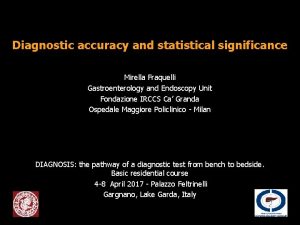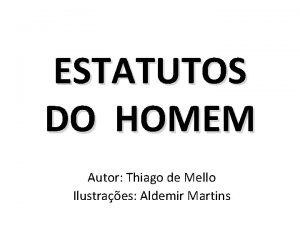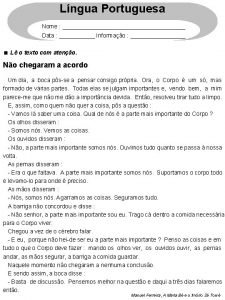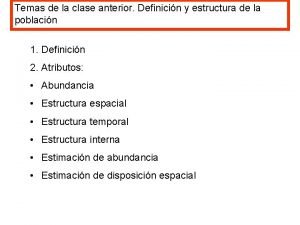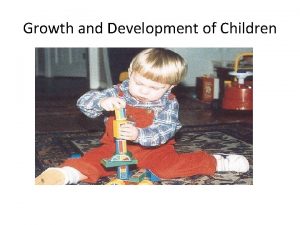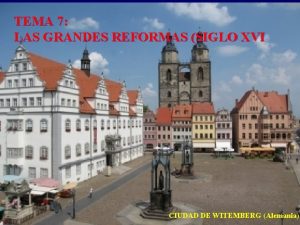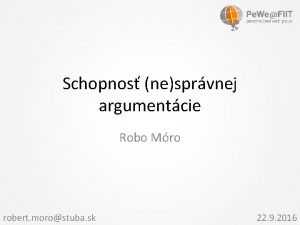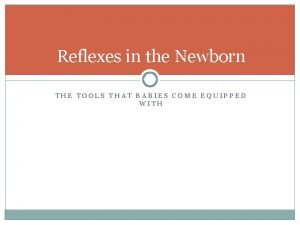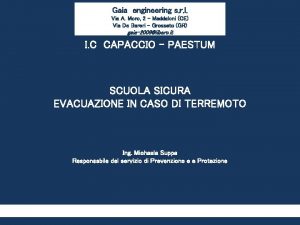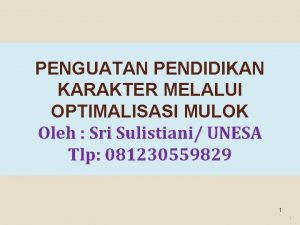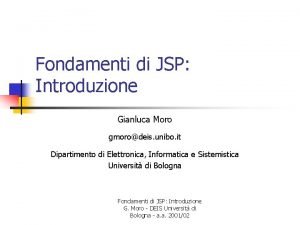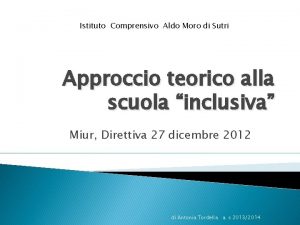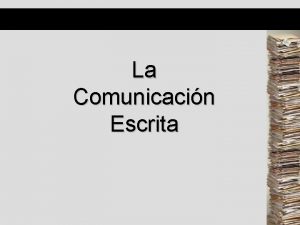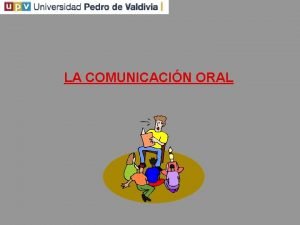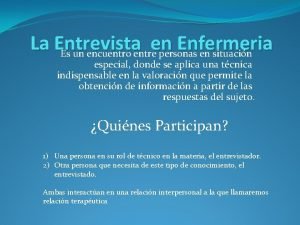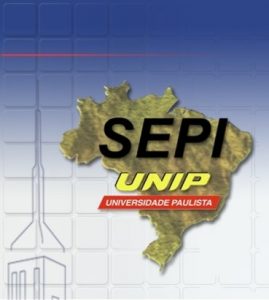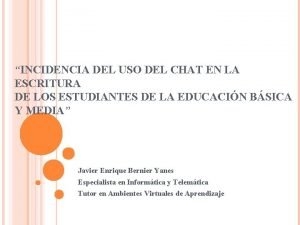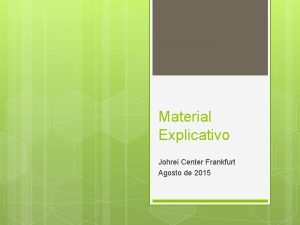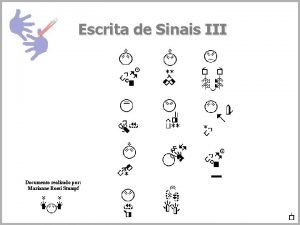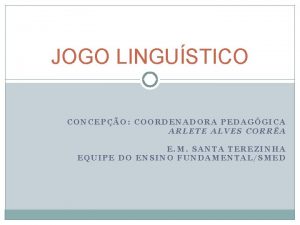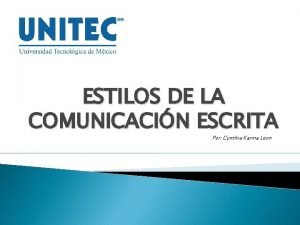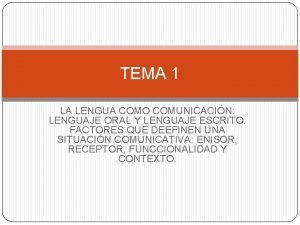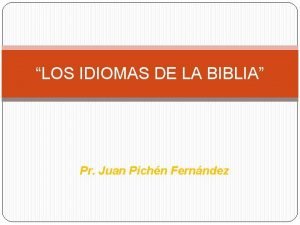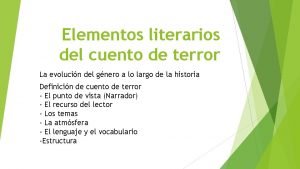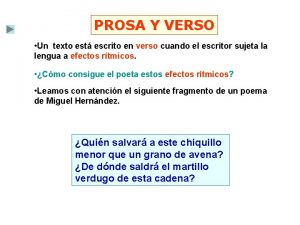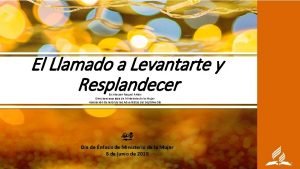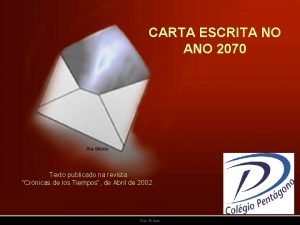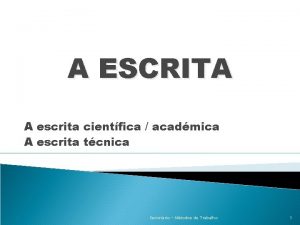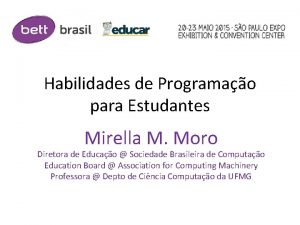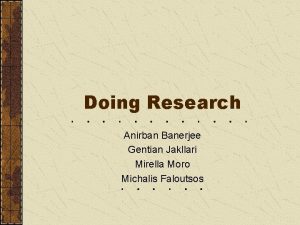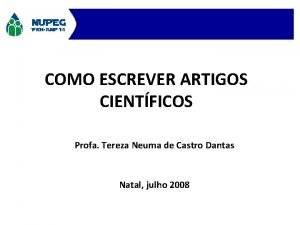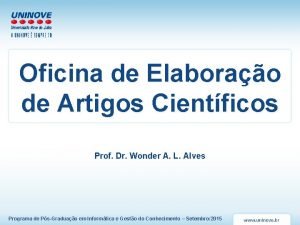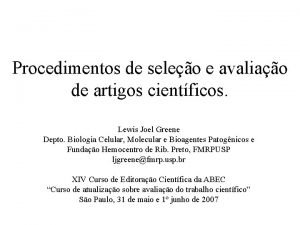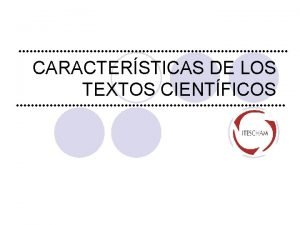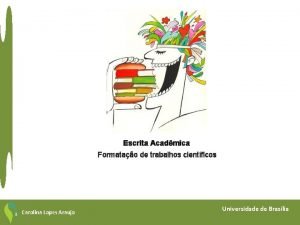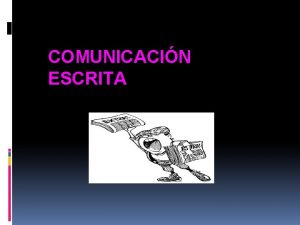Escrita de Artigos Cientficos Mirella M Moro mirelladcc





![Contexto Problema Solução Avaliação • Contexto geral • Contexto específico [estado da arte] • Contexto Problema Solução Avaliação • Contexto geral • Contexto específico [estado da arte] •](https://slidetodoc.com/presentation_image_h2/7ba419f7b7e184bd41c1c083fe0ad30f/image-6.jpg)



![Exemplo [ ZHANG et al @ SIGMOD 1996 ] Contexto Finding useful patterns in Exemplo [ ZHANG et al @ SIGMOD 1996 ] Contexto Finding useful patterns in](https://slidetodoc.com/presentation_image_h2/7ba419f7b7e184bd41c1c083fe0ad30f/image-10.jpg)




















































































![SBC Horizontes: Agosto’ 2009 • [HOW TO] Como fazer pesquisa bibliográfica Agma Juci Machado SBC Horizontes: Agosto’ 2009 • [HOW TO] Como fazer pesquisa bibliográfica Agma Juci Machado](https://slidetodoc.com/presentation_image_h2/7ba419f7b7e184bd41c1c083fe0ad30f/image-95.jpg)
























- Slides: 119

Escrita de Artigos Científicos Mirella M. Moro mirella@dcc. ufmg. br

www. dcc. ufmg. br/~mirella@dcc. ufmg. br 2

PARTE 1 INTRODUÇÃO

Fazer Pesquisa Prepara decorar o próximo slide mirella@dcc. ufmg. br 4

Enquanto estiver • • Pensando Planejando Escrevendo Apresentando Discutindo Reunindo Argumentando Contexto Problema Solução CON-PROSA: mirella@dcc. ufmg. br Avaliação 5
![Contexto Problema Solução Avaliação Contexto geral Contexto específico estado da arte Contexto Problema Solução Avaliação • Contexto geral • Contexto específico [estado da arte] •](https://slidetodoc.com/presentation_image_h2/7ba419f7b7e184bd41c1c083fe0ad30f/image-6.jpg)
Contexto Problema Solução Avaliação • Contexto geral • Contexto específico [estado da arte] • O que *não* funciona? • O que pode melhorar? • Contribuição • Como resolver o problema • É bom? É melhor? • [Nem] Sempre: Quando? Por quê? mirella@dcc. ufmg. br 6

Contribuições por TUDO!!!! Contexto Problema Solução Avaliação • X atual > novo contexto • X atual > novo problema • X atual > nova solução • Solução atual > melhorias • Diferentes avaliações > X atual mirella@dcc. ufmg. br 7

mirella@dcc. ufmg. br 8

Contribuições por TUDO!!!! Contexto Problema Solução Avaliação • Dados relacionais > streams • Dados relacionais > móveis • Dados relacionais > semiestruturado • Dados relacionais > big data analysis • Mais comum • Escolha qualquer um e avalie em: paralelo, distribuído, grandes volumes, map-reduce, novos hardwares, . . . mirella@dcc. ufmg. br 9
![Exemplo ZHANG et al SIGMOD 1996 Contexto Finding useful patterns in Exemplo [ ZHANG et al @ SIGMOD 1996 ] Contexto Finding useful patterns in](https://slidetodoc.com/presentation_image_h2/7ba419f7b7e184bd41c1c083fe0ad30f/image-10.jpg)
Exemplo [ ZHANG et al @ SIGMOD 1996 ] Contexto Finding useful patterns in large datasets has attracted considerable interest recently, Problema and one of the most widely studied problems in this area is the identification of clusters, or densely populated regions, in a multi-dimensional dataset. Prior work does not adequately address the problem of large datasets and minimization of I/O costs. Solução This paper presents a data clustering method named BIRCH (Balanced Iterative Reducing and Clustering using Hierarchies), and demonstrates that it is especially suitable for very large databases. (Detalhes) BIRCH incrementally and dynamically clusters incoming multi-dimensional metric data points to try to produce the best quality clustering with the available resources (i. e. , available memory and time constraints). BIRCH can typically find a good clustering with a single scan of the data, and improve the quality further with a few additional scans. BIRCH is also the first clustering algorithm proposed in the database area to handle “noise” (data points that are not part of the underlying pattern) effectively. Avaliação We evaluate BIRCH’s time/space efficiency, data input order sensitivity, and clustering quality through several experiments. We also present a performance comparison of BIRCH versus CLARANS, a clustering method proposed recently for laerge datasets, and show that BIRCH is consistently superior. mirella@dcc. ufmg. br 10

Conectar as Ideias: *não* é fácil Título: keyword 1 keyword 2 Contexto & Relacionados Resumo: linha 1 linha 2 linha 3 Problema Intro: par 1 par 2 par 3 par 4 Solução 1 Solução 2 Avaliação Conclusão: par 1 mirella@dcc. ufmg. br par 2 par 3 11

ERGO ESTE CURSO

ROTEIRO 2. PLANEJAMENTO 3. INÍCIO 4. CENTRO 5. FIM 6. DICAS DE ESTILO E REVISÃO

PS: na dúvida, vá à nossa biblioteca mirella@dcc. ufmg. br 14

PARTE 2 PLANEJAMENTO

As complexidades da tarefa • Como tornar um interesse vago em um problema merecedor de apresentação e solução • Como construir um argumento que motiva leitores a aceitar o que você diz • Como antecipar dúvidas de atentos mas críticos leitores e como respondê-las apropriadamente • Como criar uma introdução e conclusão que respondam à pergunta mais difícil delas, E eu com isso? • Como ler sua própria escrita como outros irão, e então aprender quando e como revisá-la FONTE: Booth, Colomb, Williams – The Craft of Research 16

1. Defina o Objetivo 1. Tópico: Estou pesquisando ______ 2. Questão: a fim de descobrir o que/como/por que ______, 3. Relevância: para ajudar outros a entender ____. FONTE: Booth, Colomb, Williams – The Craft of Research 17

Defina o Objetivo FONTE: Booth, Colomb, Williams – The Craft of Research 18

Defina o Objetivo FONTE: Booth, Colomb, Williams – The Craft of Research 19

2. Defina o Espectro • Risco = tópico tão abrangente como uma entrada de enciclopédia • Voo espacial, a sua história • Shakespeare, peças problemáticas • Tópico é geralmente muito abrangente se escrito em 4 ou 5 palavras: FONTE: Booth, Colomb, Williams – The Craft of Research 20

De tópico abrangente a específico • Com um tópico muito abrangente, você pode ficar intimidado pela ideia de encontrar, muito menos ler, sequer uma fração das fontes disponíveis • Então, deve-se reduzi-lo FONTE: Booth, Colomb, Williams – The Craft of Research 21

3. Planeje a Escrita Entenda seu público alvo • Pense em seu público alvo desde o início, sabendo que você os entenderá melhor à medida que desenvolve seu projeto • Responda as próximas perguntas cedo, então as revisite quando começar a escrever e de novo quando revisar o texto FONTE: Booth, Colomb, Williams – The Craft of Research 22

Checklist para entender seus leitores 1. Quem lerá seu texto? • Profissionais? Alunos? Torcida do Atlético? • Leitores que estão bem informados? • Leitores que sabem pouco sobre o tópico? FONTE: Booth, Colomb, Williams – The Craft of Research 23

Checklist para entender seus leitores 2. Eles esperam que faça o que pretende fazer? Deveria. . . • Diverti-los? • Apresentar novo conhecimento baseado em fatos? • Ajudá-los a entender alguma coisa melhor? • Ajudá-los a fazer algo para resolver um problema prático no mundo? FONTE: Booth, Colomb, Williams – The Craft of Research 24

Checklist para entender seus leitores 3. Quanto se espera que eles saibam? • O que eles sabem sobre seu tópico? • Qual interesse especial eles têm nele? • O que eles esperam que seja discutido? • O problema já é conhecido deles? • É um problema existente mas que eles ainda não reconhecem? • É problema apenas seu, e não deles? • Eles irão levar o problema a sério automaticamente, ou deve trabalhar para convencê-los de que é importante? FONTE: Booth, Colomb, Williams – The Craft of Research 25

Checklist para entender seus leitores 4. Como os leitores responderão ao seu trabalho? • Irá contradizer o que eles já acreditam? Como? • Eles terão algum argumento padrão contra a solução? • Eles desejarão ver todos os passos que levaram à solução? • Eles esperam que o texto siga um formato padrão? Se sim, qual? FONTE: Booth, Colomb, Williams – The Craft of Research 26

Planejamento: Exemplo Real ACM SAC/ CSBC • XML Database • XML Query Processing • Ro. XSum SIGMOD/ SBBD • XML Query Filtering • XML Routing • Ro. XSum Web. DB • XML Routing • Ro. XSum • Algorithms mirella@dcc. ufmg. br +GENÉRICO +BACKGROUND +ESPECÍFICO +DETALHES 27

Planejamento em 1 slide PRONTO • • Título Autor (es) Resumo Introdução Corpo Conclusão Referências A FAZER • Quem irá ler seu texto? evento, periódico, orientador, alunos, banca • Eles esperam que faça o que pretende fazer? contexto, novidade, contribuição, surpresa (twist) • Quanto se espera que eles saibam? profundidade/largura, background, público • Como responderão aos problemas e soluções apresentados? mirella@dcc. ufmg. br 28


PARTE 3 COMPONENTES INICIAIS

Componentes Fluxo Título: keyword 1 keyword 2 Contexto Trabalhos Relacionados Resumo: line 1 line 2 line 3 Intro: par 1 par 2 par 3 par 4 Solução 1 Solução 2 Avaliação Conclusão: par 1 mirella@dcc. ufmg. br par 2 par 3 31

TÍTULO • Referência principal ao trabalho • Chave para ser referenciado • Reflete o conteúdo do trabalho • Claro, curto, correto – Nome, não uma frase, original – Primeira coisa a se escrever? ? mirella@dcc. ufmg. br 32

Título: exemplos brasileiros • Unsupervised Information Extraction by Text Segmentation E. CORTEZ @ SBC CTD 2013 – 1º lugar doutorado • Data Mining in Large Sets of Complex Data R. CORDEIRO @ SBC CTD 2012 – 1º lugar doutorado • Análise de Dados de expressão gênica: normalização de microarrays e modelagem de redes regulatórias A. FUJITA @ SBC CTD 2008 – 1º lugar doutorado • Low Cost BIST Techniques for Linear and Non-Linear Analog Circuits M. NEGREIROS @ DATE 2006 – dissertation award • Updating relations through XML Views V. BRAGANHOLO @ SBC CTD 2005 – 1º lugar doutorado • Operadores de Seleção por Similaridade para Sistemas de Gerenciamento de Bases de Dados Relacionais A. S. ARANTES @ SBBD 2003 – best paper award mirella@dcc. ufmg. br 33

Utilizar um nome ajuda. . . mirella@dcc. ufmg. br 34

Título: exemplos Clássicos e Novos Clássicos • The Entity-Relationship Model: Toward a Unified View of Data PETER CHEN @ VLDB 1975 • Marching cubes: A high resolution 3 D surface construction algorithm W. E. LORENSEN @ SIGGRAPH 1987 • BIRCH: An Efficient Data Clustering Method for Very Large Databases T. ZHANG et al @ SIGMOD 2006 • Bigtable: A distributed storage system for structured data F. CHANG et al @ ACM TOCS 2008 • Map. Reduce: simplified data processing on large clusters J. DEAN & S. GHEMAWAT @ CACM 2008 mirella@dcc. ufmg. br 35

Trabalhar em grupo é uma faca de dois gumes mirella@dcc. ufmg. br 36

AUTOR (es) • Nome completo (“artístico”) + filiação + email • Ordem dos autores? ? – Não há regra padrão aceita globalmente • André Silva, Bento Muniz, Carlos Costa • Carlos Costa, Bento Muniz, André Silva • Bento Muniz, Carlos Costa, André Silva Aluno “dono” tese Bolsista mirella@dcc. ufmg. br Orientador 37

www. phdcomics. com mirella@dcc. ufmg. br 38

RESUMO • Um parágrafo 150 -250 palavras – Propaganda ou trailer do artigo – Atrai (ou não!) a atenção e o interesse do leitor mirella@dcc. ufmg. br 39

Resumo • Sempre menciona informações ou conclusões que estão no texto • Sem referências bibliográficas (exceto em ocasiões raras, como modificações a um método publicado previamente) • Primeiro a ser escrito: planejamento • Último a ser escrito: ideia melhor mirella@dcc. ufmg. br 40

Resumo = problema + uma boa solução. Contra exemplo: mirella@dcc. ufmg. br 41

Resumo • Sugestão 1 (uma ou duas linhas para cada item) – Escopo do trabalho – Principais objetivos – Principal resultado ou conclusão mirella@dcc. ufmg. br 42

Resumo: exemplo Contexto Problema/ Solução Avaliação Structural summaries are data structures that preserve all structural features of XML documents in a compact form. We investigate the applicability of the most popular summaries as access methods within XML query processing. In this context, issues like space and false positives introduced by the summaries need to be examined. Our evaluation reveals that the additional space required by the more precise structures is usually small and justified by the considerable performance gains that they achieve. MORO et al – WWW 2006 mirella@dcc. ufmg. br 43

Resumo • Sugestão 2 (uma a três linhas para cada item) – Contexto geral e específico – Questão/problema sendo investigado • Propósito do trabalho – Estado-da-arte • Por que precisa de uma solução nova/melhor – Solução • Nome da proposta • Metodologia básica sem detalhes • Quais características respondem as questões iniciais – Interpretação dos resultados, conclusões mirella@dcc. ufmg. br 44

Resumo: exemplo Contexto A Web é abundante em páginas que armazenam dados de forma implícita. Problema Em muitos casos, estes dados estão presentes em textos semiestruturados sem a presença de delimitadores explícitos e organizados em uma estrutura também implícita. Solução Neste artigo apresentamos uma nova abordagem para extração em textos semi-estruturados baseada em Modelos de Markov Ocultos (Hidden Markov Models - HMM). e Estado-da- Ao contrário de outros trabalhos baseados em HMM, nossa Arte abordagem dá ênfase à extração de metadados além dos dados propriamente ditos. Esta abordagem consiste no uso de uma estrutura aninhada de HMMs, onde um HMM principal identifica os atributos no texto e HMMs internos, um para cada atributo, identificam os dados e metadados. Os HMMs são gerados a partir de um treinamento com uma fração de amostras da base a ser extraída. Nossos experimentos com anúncios de classificados retirados da Avaliação Web mostram que o processo de extração alcançáveis de qualidade acima de 0, 97 com a medida F, mesmo se esta fração de treinamento é pequena. SANTOS et al @ SBBD 2006 mirella@dcc. ufmg. br 45

Resumo: exemplo Contexto Geral Publish-subscribe applications are an important class of content-based dissemination systems where the message transmission is defined by the message content, rather than its destination IP address. With the increasing use of XML as the standard format on many Contexto Internet-based applications, XML aware pub-sub applications become Específico necessary. In such systems, the messages (generated by publishers) are encoded as XML documents, and the profiles (defined by subscribers) as XML query statements. Problema As the number of documents and query requests grow, the performance and scalability of the matching phase (i. e. matching of queries to incoming documents) become vital. Estado-da-arte Current solutions have limited or no flexibility to prune out queries in advance. Solução In this paper, we overcome such limitation by proposing a novel early pruning approach called Bounding-based XML Filtering or Bo. XFilter. The Bo. XFilter is based on a new tree-like indexing structure that Método organizes the queries based on their similarity and provides lower and proposto upper bound estimations needed to prune queries not related to the incoming documents. Avaliação Our experimental evaluation shows that the early profile pruning approach offers drastic performance improvements over the current state-of-the-art in XML filtering. MORO et al @ VLDB 2007 mirella@dcc. ufmg. br 46

Resumo: exemplo Contexto e Finding useful patterns in large datasets has attracted considerable interest Problema recently, and one of the most widely studied problems in this area is the Estado-da-arte Solução Método Vantagens Avaliação identification of clusters, or densely populated regions, in a multidimensional dataset. Prior work does not adequately address the problem of large datasets and minimization of I/O costs. This paper presents a data clustering method named BIRCH (Balanced Iterative Reducing and Clustering using Hierarchies), and demonstrates that it is especially suitable for very large databases. BIRCH incrementally and dynamically clusters incoming multi-dimensional metric data points to try to produce the best quality clustering with the available resources (i. e. , available memory and time constraints). BIRCH can typically find a good clustering with a single scan of the data, and improve the quality further with a few additional scans. BIRCH is also the first clustering algorithm proposed in the database area to handle “noise” (data points that are not part of the underlying pattern) effectively. We evaluate BIRCH’s time/space efficiency, data input order sensitivity, and clustering quality through several experiments. We also present a performance comparisons of BIRCH versus CLARANS, a clustering method proposed recently for laerge datasets, and show that BIRCH is consistently superior. ZHANG et al – SIGMOD 1996 mirella@dcc. ufmg. br 47

Resumo: exemplo Contexto Today’s cloud-based services integrate globally distributed resources into Problema Solução Método Avaliação seamless computing platforms. Provisioning and accounting for the resource usage of these Internet-scale applications presents a challenging technical problem. This paper presents the design and implementation of distributed rate limiters, which work together to enforce a global rate limit across traffic aggregates at multiple sites, enabling the coordinated policing of a cloud-based service’s network traffic. Our abstraction not only enforces a global limit, but also ensures that congestion -responsive transport-layer flows behave as if they traversed a single, shared limiter. We present two designs—one general purpose, and one optimized for TCP—that allow service operators to explicitly trade off between communication costs and system accuracy, efficiency, and scalability. Both designs are capable of rate limiting thousands of flows with negligible overhead (less than 3% in the tested configuration). We demonstrate that our TCP-centric design is scalable to hundreds of nodes while robust to both loss and communication delay, making it practical for deployment in nationwide service providers. RAGHAVAN et al – SIGCOMM 2007 mirella@dcc. ufmg. br 48

INTRODUÇÃO ARTIGO = APESAR de serem ambos bem escritos mirella@dcc. ufmg. br 49

Introdução introduz mirella@dcc. ufmg. br 50

Introdução Um artigo científico não é um livro de suspense no qual o leitor só descobre o que está realmente acontecendo no capítulo final • Uma introdução bem escrita é fundamental!! • O leitor deve estar ciente do que acontece desde o início, desde a introdução mirella@dcc. ufmg. br 51

Introdução • A introdução é uma reafirmação extentida do conteúdo do Resumo ERRO MAIS COMUM Não colocar as contribuições Deixar tudo “implícito” Achar que é óbvio Óbvio não é ciência, é senso comum mirella@dcc. ufmg. br 52

Introdução • Em algum lugar (na introdução), adicionar exemplos (1 ou mais): – Como o seu trabalho pode ser empregado – Onde o seu trabalho pode ser empregado, quais os contextos, quais aplicações podem tirar vantagem – Quais problemas práticos o seu trabalho resolve mirella@dcc. ufmg. br 53

Introdução • Sugestão 1 (um ou dois parágrafos por item) – Identifica a área de interesse (palavras do título) – Contexto: revisão básica do estado-da-arte – Propósito: e/ou hipótese sendo investigada • O propósito desse trabalho é definir. . . • Esse trabalho propõe três métodos para. . . – Solução a ser detalhada • Característica fundamental, técnica/metodologia, vantagens – Organização mirella@dcc. ufmg. br 54

Introdução • Sugestão 2 (um ou dois parágrafos por item) – – – Contexto, motivação O problema em questão Trabalhos anteriores relacionados (limitações) Lista de contribuições, resultados principais Organização mirella@dcc. ufmg. br 55

Introdução Contexto • Problema • Relacionados • Solução (Organização) • Contexto, motivação • Evolução de um contexto “Yesterday’s version of distributed computing was a selfcontained, colocated server farm. Today, applications are increasingly deployed on third-party resources hosted across the Internet. Indeed, the rapid spread of open protocols and standards like Web 2. 0 has fueled an explosion of compound services that script together third-party components to deliver a sophisticated service [27, 29]. These specialized services are just the beginning: flagship consumer and enterprise applications are increasingly being delivered in the software-as-a-service model [9]. For example, Google Documents, Groove Office, and Windows Live are early examples of desktop applications provided in a hosted environment, and represent the beginning of a much larger trend. ” RAGHAVAN et al – SIGCOMM 2007 mirella@dcc. ufmg. br 56

Introdução • O problema em questão • Contexto Problema • Relacionados • Solução (Organização) – Definição do problema – Sua importância, relevância, aplicações práticas “One of the key barriers to moving traditional applications to the cloud, however, is the loss of cost control [17]. In the cloud-based services model, cost recovery is typically accomplished through metered pricing. Indeed, Amazon’s EC 2 charges incrementally per gigabyte of traffic consumed [3] […] Limiting global resource consumption in a distributed environment, however, presents a significant technical challenge. Ideally, resource providers would not require services to specify the resource demands of each distributed component a priori; such finegrained measurement and modeling can be challenging for rapidly evolving services. Instead, they should provide a fixed price for an aggregate, global usage, and allow services to consume resources dynamically across various locations, subject to the specified aggregate limit. ” RAGHAVAN et al – SIGCOMM 2007 mirella@dcc. ufmg. br 57

Introdução • Contexto • Problema Relacionados • Solução (Organização) • Trabalhos anteriores relacionados – No mesmo contexto, não resolvem o problema ou apresentam apenas soluções parciais – Extensão ou continuação de um trabalho anterior: deve ser mencionado na introdução – Uma frase sobre cada trabalho ou – Agrupar trabalhos similares e detalhar um ou dois: “. . . Como resposta a tal requisito, alguns trabalhos têm enfocado a questão do suporte a versões [2, 4, 9, 13, 27]. Entre esses, Golendziner propõe o Modelo de Versões: uma extensão aplicável a modelos de dados orientado a objetos. . . [9]” mirella@dcc. ufmg. br 58

Introdução • Solução: Contribuições principais do artigo • Contexto • Problema • Relacionados Solução (Organização) – Por extenso em um parágrafo • “Considerando o contexto atual, esse trabalho propõe. . . ” – Delimitado por itens “This paper makes three primary contributions: • Rate Limiting Cloud-based Services. We identify a key challenge. . . • Distributed Rate Limiter Design. We present the design and … • Evaluation and Methodology. We develop a methodology…” RAGHAVAN et al – SIGCOMM 2007 mirella@dcc. ufmg. br 59

Introdução • Organização • Contexto • Problema • Relacionados • Solução Organização “O restante do artigo está organizado da seguinte maneira. A seção 2 apresenta alguns conceitos básicos e discute trabalhos relacionados. A seção 3 detalha o modelo proposto. A seção 4 apresenta um estudo comparativo através de experimentos, enquanto a seção 5 conclui o trabalho. ” mirella@dcc. ufmg. br 60

ATÉ AQUI Título: keyword 1 keyword 2 Contexto Trabalhos Relacionados Resumo: line 1 line 2 line 3 Intro: par 1 par 2 par 3 par 4 Solução 1 Solução 2 Avaliação Conclusão: par 1 mirella@dcc. ufmg. br par 2 par 3 61

PARTE 4 COMPONENTE CENTRAL

Corpo • Muitas maneiras de apresentar o corpo do trabalho • Faça rascunhos com ordens diferentes • Revise com seu orientador, escolha um • Pode ser mudado enquanto o trabalho é escrito mirella@dcc. ufmg. br 63

Escrever Artigos como Arte mirella@dcc. ufmg. br 64

Corpo Exemplos de Organização 1. 2. 3. 4. 5. 6. ARANTES @ SBBD 2003 Introdução Trabalhos Relacionados Motivação e Conceitos Fundamentais Composição de Operadores por Similaridade: os Novos Algoritmos Experimentos Realizados Conclusões e Trabalhos Futuros 1. 2. 3. 4. 5. 6. BRAGANHOLO @ CTD 2005 Introduction Related Work Query Trees Update Language Mapping Summary and Concluding Remarks mirella@dcc. ufmg. br 65

Corpo Exemplos de Organização 1. 2. 3. 4. 5. 6. 7. 8. LORENSEN @ SIGGRAPH 87 Introduction Information flow for 3 D medical algorithms Related work Marching cube algorithm Enhancements of the basic algorithm Implementation Results Conclusions 1. 2. 3. 4. 5. WEYUKER @ TSE 88 Introduction Definitions Complexity Measures Desired Properties of Complexisty Measures Conclusions, Summary, and Future Directions mirella@dcc. ufmg. br 66

Corpo Exemplos de Organização 1. 2. 3. 4. 5. 6. 7. ZHANG @ SIGMOD 1996 Introduction Summary of Relevant Research Background Clustering Feature and CF Tree The BIRCH Clustering Algorithm Performance Studies Summary and Future Research RAGHAVAN @ SIGCOMM 07 mirella@dcc. ufmg. br 1. 2. 3. 4. 5. 6. 7. Introduction Classes of Clouds Limiter Design Evaluation Methodology Evaluation Related Work Conclusion 67

Corpo Exemplos de Organização CHANG et al@ ACM TOCS 08 1. 2. 3. 4. 5. 6. 7. 8. 9. 10. 11. 12. 13. Introduction Data Model API Building Blocks Implementation Refinements Performance Evaluation Real Applications Lessons Related Work Conclusions Acknowledgements References DEAN, GHEMAWAT @ CACM 08 1. Introduction 2. Programming Model 3. Implementation 4. Refinements 5. Performance 6. Experience 7. Related Work 8. Conclusions 9. Acknowledgements 10. References mirella@dcc. ufmg. br 68

Corpo Exemplos de Organização 1. Introdução 2. O que já existe Estado-da-arte 3. NOVIDADE 4. VALIDAÇÃO 5. Conclusão A. B. C. D. E. Conceitos Básicos MODELO LINGUAGEM; IMPLEMENTAÇÃO ESTUDO DE CASO Trabalhos Relacionados A. B. C. D. E. F. Conceitos Básicos Trabalhos Relacionados ARQUITETURA; ALGORITMOS ANÁLISE COMPARATIVA EXPERIMENTOS Discussão mirella@dcc. ufmg. br 69

Verificar o que já existe evita reinventar o passado mirella@dcc. ufmg. br 70

Já existe • Novidade • Validação • Discussão O que já Existe • Conceitos Básicos e Trabalhos Relacionados • Apresentados juntos/não • Conceitos Básicos antes da contribuição principal • Trabalhos Relacionados no início ou fim mirella@dcc. ufmg. br 71

O que já Existe: Conceitos Básicos l l l l Definições Notações Modelos Arquiteturas Linguagens Cenários Padrões necessários para entender o trabalho • Referências para trabalhos onde os conceitos são introduzidos ou melhor detalhados mirella@dcc. ufmg. br 72

O que já Existe: Trabalhos Relacionados • Como o artigo avança o estado-da-arte • O que antes não tinha, e agora tem • Foco: trabalhos RELACIONADOS a pesquisa apresentada no artigo mirella@dcc. ufmg. br 73

O que já Existe: Trabalhos Relacionados • Trabalhos anteriores com temas relacionados ao seu • Mencionar todos os trabalhos relacionados (pessoal do comitê de programa, depto) • Detalhes desses trabalhos ajudam mostrar onde o seu trabalho é melhor ou • Desvantagens ou pontos fracos de trabalhos anteriores que são aprimorados • Condições, requisitos e limitações do seu trabalho mirella@dcc. ufmg. br 74

O que já Existe: Trabalhos Relacionados • Seção de Trabalhos Relacionados é praticamente obrigatória • Por exemplo, o título é: “Resumos Estruturais em Processamento de Consulta XML” Exemplos de temas relacionados: – Resumos estruturais em outros contextos (outros processamentos) – Resumos estruturais para processar outros tipos de dados – Outras formas de processar consultas XML –. . . mirella@dcc. ufmg. br 75

O que já Existe: Trabalhos Relacionados • Mas o artigo é um survey, precisa de trabalhos relacionados? ? ? – SIM – É impossível que um artigo referencie todos os outros – Que outros trabalhos ficaram fora do survey e por quê? • Precisa ter uma seção para Trabs. Rels? Não pode ir simplesmente mencionando os artigos aqui e ali no meio do artigo? – Melhor não – Melhor ter todos os artigos em uma seção – COMPARANDO com o trabalho em questão mirella@dcc. ufmg. br 76

Cuidado!!!!! mirella@dcc. ufmg. br 77

Novidade: Contribuições • Já existe Novidade • Validação • Discussão • Parte principal do artigo!!!! • A que veio • Adiciona o que • Tem de estar claríssimo mirella@dcc. ufmg. br 78

Novidade: Contribuições • Um parágrafo com ideia geral da proposta • Esclareça novas definições (escreva claramente que são novas definições propostas no artigo) • Adicione quantos parágrafos necessários para apresentar: – – o que é o trabalho como funciona a proposta o que é novidade, por que detalhes e explicações sobre partes principais do funcionamento da proposta mirella@dcc. ufmg. br 79

EXPLICITAMENTE O que Como Por que Onde Quanto mirella@dcc. ufmg. br 80

PARTE 5 COMPONENTES FINAIS

Validação / Avaliação • Já existe • Novidade Validação • Discussão • Mostrar que a solução proposta funciona e seus benefícios • Análise • Estudo de caso • Experimentos mirella@dcc. ufmg. br 82

Validação: Análise • Proposta é correta (demonstração e provas) • Inclua (conforme necessário): – Um parágrafo com o resumo do que é provado nessa seção – Um parágrafo com definições específicas usadas na análise (ex. estruturas usadas nas provas) – Provas e análises – Comentários finais sobre o significado das provas de um modo intuitivo ou num nível mais prático mirella@dcc. ufmg. br 83

Validação: Estudo de Caso • Proposta é aplicável, implementável • Inclua (conforme necessário): – Contexto geral – Regras ou condições específicas necessárias nesse estudo de caso – Modelagem / Implementação – Funcionamento – Vantagens e desvantagens de usar o modelo proposto nesse estudo de caso mirella@dcc. ufmg. br 84

Validação: Experimentos • Proposta funciona, desempenho bom/superior • Inclua (conforme necessário): – Contexto: o que é medido, o que não é, por que – Modelo de simulação ou infraestrutura das medições: configuração do sistema, tipo de máquinas usadas, linguagens, . . . – Resultados experimentos [próximo slide] – Comentários finais, discussões, explicações adicionais mirella@dcc. ufmg. br 85

Validação: Experimentos • Descrição de resultados – Subtítulo (em negrito): para diferenciar experimentos (ex: avaliando tamanho da entrada, variando a quantidade de consultas, usando dados sintéticos, usando dados reais, . . . ) – Razão clara: por que cada gráfico aparece no seu artigo (ex: conforme o tamanho dos arquivos de entrada aumenta, o throughput diminui, . . . ) – Explicar: os axis, o que o gráfico mostra, qual é a tendência, por que a tendência aparece, por que um algoritmo apresenta melhores resultados que outro, . . . – Auto-contido: legendas devem ser legíveis e compreensíveis e suficientes para entender o gráfico mirella@dcc. ufmg. br 86

Experimentos: Exemplo • Performance studies – – – – 6. 1 Analysis 6. 2 Synthetic Dataset Generator 6. 3 Parameters and Default Setting 6. 4 Base Workload Performance 6. 5 Sensitivity to Parameters 6. 6 Time Scalability 6. 7 Comparison of BIRCH and CLARANS 6. 8 Application to Real Datasets ZHANG @ SIGMOD 1996 mirella@dcc. ufmg. br 87

Experimentos: Moral da História mirella@dcc. ufmg. br 88

Discussão • Discussão • Já existe • Novidade • Validação Discussão – Pode ser incluída como subseção final de Experimentos ou na Conclusão – Relacionamentos entre os fatos e resultados observados – Princícios, relações, generalizações mostrados nos Experimentos – Exceção ou falta de relação, pontos incertos – Mostrar que resultados e interpretações concordam (ou contrastam) com trabalhos previamente publicados – Implicações teóricas e possíveis aplicações práticas • Conclusão – Principal contribuição – Evidências para cada conclusão (não assuma que o leitor é super capaz de juntar todos os pontos sozinho) mirella@dcc. ufmg. br 89

Você = maior fã do seu trabalho mirella@dcc. ufmg. br 90

CONCLUSÃO • Sugestão: ser mais específico que na introdução e informar (um parágrafo/linha por item) resumo do que o artigo apresentou principais resultados e contribuições comentários sobre a importância, relevância ou dicas para o uso prático do seu trabalho (como os resultados experimentos podem ajudar na prática. . . ) – trabalhos futuros (evite entregar suas ideias de trabalhos mais inovadores de graça!!) – – mirella@dcc. ufmg. br 91

Conclusão: exemplo “As cloud-based services transition from marketing vaporware to real, deployed systems, the demands on traditional Web-hosting and Internet service providers are likely to shift dramatically. In particular, current models of resource provisioning and accounting lack the flexibility to effectively support the dynamic composition and rapidly shifting load enabled by the software as a service paradigm. We have identified one key aspect of this problem, namely the need to rate limit network traffic in a distributed fashion, and provided two novel algorithms to address this pressing need. Our experiments show that naive implementations based on packet arrival information are unable to deliver adequate levels […] Our results demonstrate that it is possible to recreate, at distributed points in the network, the flow behavior that end users and network operators expect from a single centralized rate limiter. Moreover, it is possible […]” RAGHAVAN et al - SIGCOMM 2007 mirella@dcc. ufmg. br 92

Referências são importantes, sempre mirella@dcc. ufmg. br 93

REFERÊNCIAS • Corretas, completas, específicas • Informações obrigatórias: autores, título, nome do evento ou periódico (editora), volume e número se necessário, ano • Referências relevantes – Do mesmo ano (ou ano anterior) para ilustrar que o tópico é atual e de interesse da comunidade – Artigos de conferências, periódicos, livros (não apenas sites da Internet!) – Todas as obras listadas no conjunto de referências devem ser mencionadas no texto, e vice-versa mirella@dcc. ufmg. br 94
![SBC Horizontes Agosto 2009 HOW TO Como fazer pesquisa bibliográfica Agma Juci Machado SBC Horizontes: Agosto’ 2009 • [HOW TO] Como fazer pesquisa bibliográfica Agma Juci Machado](https://slidetodoc.com/presentation_image_h2/7ba419f7b7e184bd41c1c083fe0ad30f/image-95.jpg)
SBC Horizontes: Agosto’ 2009 • [HOW TO] Como fazer pesquisa bibliográfica Agma Juci Machado Traina, Caetano Traina Jr. , ICMC-USP São Carlos Por onde devo começar quando quero iniciar uma pesquisa bibliográfica? Este artigo visa responder a essa questão, apresentando ao jovem pesquisador os passos principais para realizar uma pesquisa bibliográfica que contemple seu objetivo, bem como as ferramentas básicas amplamente disponíveis para ser bem sucedido. mirella@dcc. ufmg. br 95

PARTE 6 DICAS DE ESTILO E REVISÃO

DICAS DE ESTILO SETE pecados capitais 1. Frases longas (repletas de vírgulas ou não!) 2. Erros ortográficos 3. Tradução literal e imbromation 4. Imagens/tabelas ilegíveis 5. Erros gramaticais (paralelismo, concordância, conjugação, crase) 6. Cópia literal 7. Blablabla (encher linguiça) mirella@dcc. ufmg. br 97

Dicas de Estilo • Siga o formato – Confira cuidadosamente a seção de "Instruções a Autores"/"Instruções para Submissão" – Artigos podem ser recusados apenas por não seguir o formato requisitado (independente da qualidade de seu conteúdo) • Cópia literal não!!! – Quando referenciar outros trabalhos, resuma suas idéias principais – Resista à tentação de copiar literalmente colocando o texto entre “. . ” mirella@dcc. ufmg. br 98

Dicas de Estilo • Palavras estrangeiras em itálico • Siglas esclarecidas – Colocar seu significado entre parênteses – “. . . conforme definido pela W 3 C (World Wide Web Consortium). . . ” – Lembre-se que pode existir sobreposição mirella@dcc. ufmg. br 99

Dicas de Estilo • Uma imagem vale mil palavras – Trabalho apresenta um processo complicado, cheio de fases, entradas e saídas para lá e para cá, tente resumir tudo em uma imagem – Uma nova arquitetura • Escreva enquanto trabalha – É uma boa idéia começar a escrever o artigo enquanto o trabalho está em desenvolvimento (enquanto idéias, problemas, soluções e detalhes estão mais frescos na memória) • REVISAR! • Backup! mirella@dcc. ufmg. br 100

REVISÃO FINAL Verificar antes da Submissão • Ortografia de título, nomes dos autores e filiação • Imprima o artigo (no formato final de submissão): tudo legível • Tenha certeza absoluta da data e do horário limites para submissão de trabalhos • MS Word: – Numeração das seções e subseções – Numeração no texto concorda com a numeração usada em figuras e tabelas – Referências cruzadas não foram perdidas dentro do editor mirella@dcc. ufmg. br 101

Revisão Final Exemplo de Formulário de Avaliação • Relevância (enquadramento no evento) • • • Originalidade Mérito técnico-científico Apresentação Organização Legibilidade (readability) Referências MAIS NA AULA “Como revisar artigos” mirella@dcc. ufmg. br 102

EM RESUMO Título inicial do trabalho Autores Aluno + Orientador(es) Resumo / Abstract Contexto + problema + objetivos 1. Introdução Contexto + motivação + problema + estado-da-arte + contribuições + organização 2. O que já existe Estado-da-arte: comparação 3. NOVIDADE Contribuições + trabalho desenvolvido 4. Validação: análise, estudo, experimentos 5. Conclusão Estado atual + próximos passos 6. Referências Local (DCC) + nacional + internacional mirella@dcc. ufmg. br 103

Perguntas? ? ? mirella@dcc. ufmg. br www. dcc. ufmg. br/~mirella

Estudo de Caso VLDB 2007 Best Paper Awards Scalable Semantic Web Data Management Using Vertical Partitioning Daniel J. Abadi, Adam Marcus, Samuel Madden, Katherine J. Hollenbach Tem um formato particular mirella@dcc. ufmg. br 105

Estudo: Abstract • • • Efficient management of RDF data is an important factor in realizing the semantic Web vision. Performance and scalability issues are becoming increasingly pressing as Semantic Web technology is applied to real-world applications. In this paper, we examine the reasons why current data management solutions for RDF data scale poorly, and explore the fundamental scalability limitations of these approaches. We review the state of the art for improving performance for RDF databases and consider a recent suggestion, “property tables. ” We then discuss practically and empirically why this solution has undesirable features. As an improvement, we propose an alternative solution: vertically partitioning the RDF data. We compare the performance of vertical partitioning with prior art on queries generated by a Web-based RDF browser over a large-scale (more than 50 million triples) catalog of library data. Our results show that a vertical partitioned schema achieves similar performance to the property table technique while being much simpler to design. Further, if a columnoriented DBMS (a database architected specially for the vertically partitioned case) is used instead of a row-oriented DBMS, another order of magnitude performance improvement is observed, with query times dropping from minutes to several seconds. mirella@dcc. ufmg. br 106

Estudo: Introduction • • The Semantic Web is an effort by the W 3 C [8] to enable integration and sharing of data across different applications and organizations. Though called the Semantic Web, the W 3 C envisions something closer to a global database than to the existing World Wide Web. In the W 3 C vision, […]. Database researchers will immediately recognize that building the Semantic Web requires surmounting many of the semantic heterogeneity problems faced by the database community over the years. In fact – as in many database research efforts – the W 3 C has proposed schema matching, ontologies, and schema repositories for managing semantic heterogeneity. One area in which the Semantic Web community differs from the relational database community is in its choice of data model. The Semantic Web data model, called the “Resource Description Framework, ” [9] or RDF, represents data as statements about resources using a graph connecting resource nodes and their property values with labeled arcs representing properties. Syntactically, […]. For example, to represent the fact that Serge Abiteboul, Rick Hull, and Victor Vianu wrote a book called “Foundations of Databases” we would use seven triples: […] O artigo tem de explicar esses conceitos: Trata da área de Web Semântica em um evento de Banco de Dados mirella@dcc. ufmg. br 107

Estudo: Introduction • • The commonly stated advantage of this approach is that it is very general […] These tools won’t be useful if different users describe objects differently, so the Semantic Web community has developed a set of standards for expressing schemas (RDFS and OWL); these make it possible, for example, to say that every book should have an author, or that the property “is. Author” is the same as the property “authored. ” This data representation, though flexible, has the potential for serious performance issues, since there […]. For example, […] Figure 1. This query is potentially very slow to execute, since as the number of triples in the library collection scales, the RDF table may well exceed the size of memory, and each of these filters and joins will require a scan or index lookup. Real world queries involve many more joins, which complicates selectivity estimation and query optimization, and limits the benefit of indices. mirella@dcc. ufmg. br 108

Estudo: Introduction • As a database researcher, it is tempting to dismiss RDF, as the data model seems to offer inherently limited performance for little – or no – improvement in expressiveness or utility. Regardless of one’s opinion of RDF, however, it appears to have a great deal of momentum in the web community, with several international conferences (ISWC, ESWC) each drawing more than 250 full paper submissions and several hundred attendees, as well as enthusiastic support from the W 3 C (and its founder, Tim Berners-Lee. ) Further, an increasing amount of data is becoming available on the Web in RDF format, including the Uni. Prot comprehensive catalog of protein sequence, function, and annotation data (created by joining the information contained in Swiss-Prot, Tr. EMBL, and PIR) [6] and Princeton University’s Word. Net (a lexical database for the English language) [7]. The online Semantic Web search engine Swoogle [5] reports that it indexes 2, 171, 408 Semantic Web documents at the time of the publication of this paper. Vende o peixe para a comunidade de BD mirella@dcc. ufmg. br 109

Estudo: Introduction • • • Hence, it is our goal in this paper to explore ways to improve RDF query performance, since […]. We focus on […] The gist of our technique is based on a simple and familiar observation to proponents of relational technology: […] We look at two different physical organization techniques for RDF data. The first, called the property table technique, denormalizes […]. For example, “title, ” “author, ” and “isbn” might all be properties that tend to be defined for subjects that represent book entities. […] This flattened property table representation will require many fewer joins to access, since self-joins on the subject column can be eliminated. One can use standard query rewriting techniques to translate queries over the RDF triple-store to queries over the flattened representation. There are several issues with this property table technique, including: – NULLs. Because […] – Multi-valued Attributes. […] – Proliferation of union clauses and joins. In the above example, […] Fornece uma primeira solução que requer menos joins. Explica os problemas desta solução. mirella@dcc. ufmg. br 110

Estudo: Introduction • To address these limitations, we propose a different physical organization technique for RDF data. We create a two-column table […] For the library example, […] Although many joins are still required to answer queries over multiple properties, each table is sorted by subject, so fast (linear) merge joins can be used. Further, only those properties that are accessed by the query need to be read off disk (or from memory), saving I/O time. Fornece uma segunda solução • The above technique can be thought of as a fully vertically partitioned database on property value. Although vertically partitioning a database can be done in a normal DBMS, these databases are not optimized for these narrow schemas (for example, the tuple header dominates the size of the actual data resulting in table scans taking 4 -5 times as long as they need to), and there has been a large amount of recent work on column-oriented databases [19, 20, 29, 31], which are DBMSs optimized for vertically partitioned schemas. Explica a diferença da nova técnica para as anteriores (da própria comunidade de BD) mirella@dcc. ufmg. br 111

Estudo: Introduction • • • In this paper, we compare the performance of different RDF storage schemes on a real world RDF dataset. We use the Postgres open source DBMS to show that both the property table and the vertically partitioned approaches outperform the standard triplestore approach by more than a factor of 2 (average query times go from around 100 seconds to around 40 seconds) and have superior scaling properties. We then show that one can get another order of magnitude in performance improvement by using a column -oriented DBMS since they are designed to perform well on vertically partitioned schemas (queries now run in an average of 3 seconds). The main contributions of this paper are: an overview of the state of the art for storing RDF data in databases, a proposal to vertically partition RDF data as a simple way to improve RDF query performance relative to the state of the art, a description of how we extended a column-oriented database to implement the vertical partitioning approach, and a performance evaluation of these different proposals. Ultimately, the columnoriented DBMS is able to obtain near-interactive performance (on non-trivial queries) over real-world RDF datasets of many millions of records, something that (to the best of our knowledge) no other RDF store has been able to achieve. The remainder of this paper is organized as follows. […] mirella@dcc. ufmg. br 112

Estudo: Corpo 2. Current State of the Art In this section, we discuss the state of the art of storing RDF data in relational databases, with an extended look at the property table approach. 2. 1 RDF in RDBMSs 2. 2 Property Tables 3. A Simpler Alternative We now look at an alternative to the property table solution to speed up queries over a triple-store. In Section 3. 1 we discuss the vertically partitioned approach to storing RDF triples. We then look at how we extended a column-oriented DBMS to implement this approach in Section 3. 2 3. 1 Vertically Partitioned Approach 3. 2 Extending a Column-Oriented DBMS mirella@dcc. ufmg. br 113

Estudo: Corpo 4. Materialized Path Expressions 5. Benchmark In this section, we describe the RDF benchmark we have developed for evaluating the performance of our three RDF databases. Our benchmark is based on publicly available library data and a collection of queries generated from a web-based user interface for browsing RDF content. 5. 1 Barton Data 5. 2 Longwell Overview 5. 3 Longwell Queries mirella@dcc. ufmg. br 114

Estudo: Validação 6. Evaluation Now that we have described our benchmark dataset and the queries that we run over it, we compare their performance in three different schemas – a triples schema, a property tables schema, and a vertically partitioned schema. We study the performance of each of these three schemas in a row-store (Postgres) and, for the vertically partitioned schema, also in a column-store (our extension of C-Store). Our goal is to study the performance tradeoffs between these representations to understand when a vertically partitioned approach performs better (or worse) than the property tables solution. Ultimately, the goal is to improve performance as much as possible over the triplestore schema, since this is the schema most RDF store systems use. mirella@dcc. ufmg. br 115

Estudo: Validação 6. 1 System 6. 1. 1 Postgre. SQL Database (por que? configurações) 6. 2 Store Implementation Details We now describe the details of our store implementations. Note that all implementations feature a dictionary encoding table that maps strings to integer identifiers (as was described in Section 2. 1); these integers are used instead of strings to represent properties, subjects, and objects. The encoding table has a clustered B+tree index on the identifiers, and an unclustered B+tree index on the strings. We found that all experiments, including those on the triplestore, went an order of magnitude faster with dictionary encoding. 6. 2. 1 Triple Store 6. 2. 2 Property Table Store 6. 2. 3 Vertically Partitioned Store in Postgres 6. 2. 4 Column-Oriented Store 6. 3 Query Implementation Details In this section, we discuss the implementation of all seven benchmark queries in the four designs described above. mirella@dcc. ufmg. br 116

Estudo: Validação 6. 4 Results 6. 4. 1 Postgres as a Choice of RDBM 6. 5 Scalabililty 6. 6 Materialized Path Expressions 6. 7 The Effect of Further Widening mirella@dcc. ufmg. br 117

Estudo: Conclusão The emergence of the Semantic Web necessitates high performance data management tools to manage the tremendous collections of RDF data being produced. Current state of the art RDF databases – triple-stores – scale extremely poorly since most queries require multiple self-joins on the triples table. The previously proposed “property table” optimization has not been adopted in most RDF databases, perhaps due to its complexity and inability to handle multi-valued attributes. We showed that a poorly-selected property table can result in a factor of 3. 8 slowdown over an optimal property table, thus making the solution difficult to use in practice. As an alternative to property tables, we proposed vertically partitioning tables and demonstrated that they achieve similar performance as property tables in a row-oriented database, while being simpler to implement. Further, we showed that on a version of the C-Store column-oriented database, it is possible to achieve a factor of 32 performance improvement over the current state of the art triple store design. Queries that used to take hundreds of seconds can now be run in less than ten seconds, a significant step toward interactive time semantic web content storage and querying. mirella@dcc. ufmg. br 118

Estudo: Acknowledgments • We thank George Huo and the Postgres development team for their advice on our Postgres implementation, and Michael Stonebraker for his feedback on this paper. This work was supported by the National Science Foundation under grants IIS-048124, CNS- 0520032, IIS-0325703 and two NSF Graduate Research Fellowships. mirella@dcc. ufmg. br 119
 Senaculo
Senaculo Moro moro
Moro moro Uri ng dula sa panahon ng kastila
Uri ng dula sa panahon ng kastila Comedia or moro-moro
Comedia or moro-moro Mirella gomes
Mirella gomes Sensitivity vs specificity
Sensitivity vs specificity Pdagog
Pdagog Dra mirella gastropediatra
Dra mirella gastropediatra Greniol
Greniol Mirella ciobanu
Mirella ciobanu Mirella gomes de souza
Mirella gomes de souza Mirella p
Mirella p Mirella gomes de souza
Mirella gomes de souza Mirella at foxboro
Mirella at foxboro Uso dos artigos
Uso dos artigos Determinantes e pronomes demonstrativos
Determinantes e pronomes demonstrativos Determinantes artigos
Determinantes artigos Estatuto do homem
Estatuto do homem Determinantes pessoais
Determinantes pessoais Artigo definido
Artigo definido Determinantes artigos definidos e indefinidos
Determinantes artigos definidos e indefinidos Bicho moro
Bicho moro Itc chamilo
Itc chamilo Movimientos segmentales y totales
Movimientos segmentales y totales Moro reflex absent
Moro reflex absent Romance del rey moro
Romance del rey moro Antropocentrismo características
Antropocentrismo características Tomas moro
Tomas moro Moro alkar
Moro alkar Robert moro
Robert moro Ljiljana moro
Ljiljana moro Contact comfort psychology definition
Contact comfort psychology definition Reflexes in newborn
Reflexes in newborn Gaia engineering
Gaia engineering Que representa el alfaqui de barba crecida y cana
Que representa el alfaqui de barba crecida y cana Wedhatama tegese
Wedhatama tegese Romance del rey moro que perdió alhama
Romance del rey moro que perdió alhama Quien fue tomas moro
Quien fue tomas moro Canto de la perdi
Canto de la perdi Cardiopulmonary
Cardiopulmonary Francesco moro unibo
Francesco moro unibo Istituto comprensivo di sutri
Istituto comprensivo di sutri Cual es el tono del poema romance del rey moro
Cual es el tono del poema romance del rey moro Liceo moro reggio emilia
Liceo moro reggio emilia Sceriffo moro
Sceriffo moro Prensa escrita concepto
Prensa escrita concepto Comunicacin escrita
Comunicacin escrita A era da escrita
A era da escrita Ventajas entre comunicacion oral y escrita
Ventajas entre comunicacion oral y escrita Constancia de compra
Constancia de compra Leitura e escrita de textos argumentativos sacrini pdf
Leitura e escrita de textos argumentativos sacrini pdf Secuencia del espiritu santo escrita
Secuencia del espiritu santo escrita Definición de biografía y autobiografía
Definición de biografía y autobiografía Reconhecimento de escrita
Reconhecimento de escrita La entrevista de enfermeria
La entrevista de enfermeria Como hacer la presentacion de un trabajo
Como hacer la presentacion de un trabajo Tipos de comunicação escrita
Tipos de comunicação escrita Enem gerente boa tarde
Enem gerente boa tarde Palabra de dios escrita
Palabra de dios escrita Que es lengua hablada y lengua escrita
Que es lengua hablada y lengua escrita Escrita fracionária
Escrita fracionária Pausas orales y escritas
Pausas orales y escritas Aspectos formales de la lengua escrita
Aspectos formales de la lengua escrita Descendente y ascendente
Descendente y ascendente Comunicacion escrita verbal y corporal
Comunicacion escrita verbal y corporal Exemplo de metodologia de um trabalho de pesquisa
Exemplo de metodologia de um trabalho de pesquisa Las ovejas blancas comen más que las ovejas negras
Las ovejas blancas comen más que las ovejas negras Niveis de escrita emilia ferreiro
Niveis de escrita emilia ferreiro Ohikari significado
Ohikari significado Un leyenda
Un leyenda La carta 2070
La carta 2070 Elementos notacionais da escrita atividades
Elementos notacionais da escrita atividades Saber y conocer
Saber y conocer Escrita de sinais
Escrita de sinais Niveis de escrita
Niveis de escrita Da fala para a escrita atividades de retextualização
Da fala para a escrita atividades de retextualização Comunicacin escrita
Comunicacin escrita Estilos de la comunicación escrita
Estilos de la comunicación escrita Comunicacin escrita
Comunicacin escrita Fonte escrita
Fonte escrita Simpatico es una palabra aguda grave o esdrujula
Simpatico es una palabra aguda grave o esdrujula Lenguajes de la biblia
Lenguajes de la biblia Lean lleva acento
Lean lleva acento Comunicacin escrita
Comunicacin escrita Pai celeste eu preciso de ti
Pai celeste eu preciso de ti Oração do credo escrita
Oração do credo escrita Textura escrita
Textura escrita Elementos de un cuento de terror
Elementos de un cuento de terror Texto escrito en versos y estrofas
Texto escrito en versos y estrofas Sermon levantate y resplandece
Sermon levantate y resplandece Características de la prensa escrita
Características de la prensa escrita El hilo rojo leyenda corta
El hilo rojo leyenda corta Cultura oral y escrita
Cultura oral y escrita La leyenda de la llorona
La leyenda de la llorona Carta escrita no ano 2070
Carta escrita no ano 2070 Que es la produccion escrita
Que es la produccion escrita Cuenta la leyenda caco y vale
Cuenta la leyenda caco y vale








